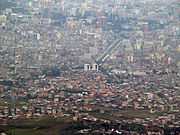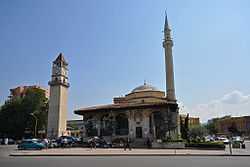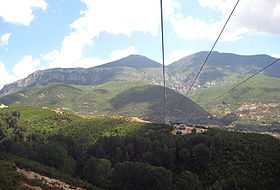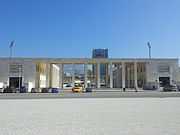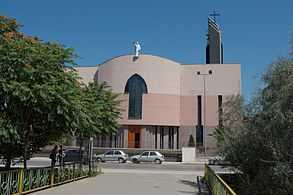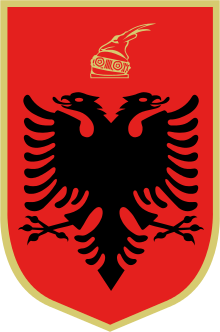Tirana
| Tirana Tiranë | |||
|---|---|---|---|
| Municipality | |||
| |||
 Tirana Location of Tirana in Albania | |||
| Coordinates: 41°19′48″N 19°49′12″E / 41.33000°N 19.82000°E | |||
| Country |
| ||
| County |
| ||
| Founded | 1614 | ||
| Subdivisions | 11 Municipal Units | ||
| Government | |||
| • Mayor | Lulzim Basha (PD)[1] | ||
| • Government | City Council | ||
| Area | |||
| • Municipality | 41.8 km2 (16.1 sq mi) | ||
| • Metro | 1,652 km2 (638 sq mi) | ||
| Elevation | 110 m (360 ft) | ||
| Population (2011)[2] | |||
| • Municipality | 621,286 | ||
| • Density | 10,553/km2 (27,330/sq mi) | ||
| • Urban | 418,495 | ||
| • Urban density | 14,746/km2 (38,190/sq mi) | ||
| • Metro | 802,523 | ||
| Time zone | CET (UTC+1) | ||
| • Summer (DST) | CEST (UTC+2) | ||
| Postal code | 1001–1028[3] | ||
| Area code(s) | +355 4 | ||
| Website |
www | ||
Tirana ![]() i/tɨˈrɑːnə/ (Standard Albanian: Tiranë; regional Gheg Albanian: Tirona) is the capital and largest city of Albania.
i/tɨˈrɑːnə/ (Standard Albanian: Tiranë; regional Gheg Albanian: Tirona) is the capital and largest city of Albania.
Tirana became Albania’s capital city in 1920. The population at the 2011 census was 418,495.[4]
The city is host to many public institutions and public and private universities, and is the centre of the political, economic, and cultural life of the country.
Geography

The Municipality of Tirana is located at (41.33°N, 19.82°E) in Tirana County, about 32 kilometers (20 mi) inland. Tirana's average altitude is 110 meters (360 ft) above sea level and its highest point measures 1,828 m (5,997.38 ft) at Mali me Gropa. The city is mostly surrounded by hills, with Dajti Mountain on the east and a slight valley opening on the north-west overlooking the Adriatic Sea in the distance. The Tiranë river runs through the city, as does the Lanë stream. The city borders the surrounding municipalities of Paskuqan, Dajt, Farkë, Vaqarr, Kashar and Kamëz.
The city has four artificial lakes: the Tirana Artificial Lake around which was built the Big Park, Paskuqani Lake, Farka Lake, and Tufina Lake.
Tirana is on the same parallel as Naples, Madrid, Istanbul, and New York, and on the same meridian as Budapest and Kraków.
History
Antiquity
The area occupied by Tirana has been populated since the Paleolithic era,[5] dating back 10,000 to 30,000 years ago, as suggested by evidence from tools excavated near Mount Dajt's quarry and in Pellumba Cave. As argued by various archaeologists, Tirana and its suburbs are filled with Illyrian toponyms, as its precincts are some of the earliest inhabited regions in Albania.[6]
The oldest discovery in downtown Tirana was a Roman house, later transformed into an aisleless church with a mosaic-floor, dating to the 3rd century A.D., with other remains found near a medieval temple at Shengjin Fountain in the eastern suburbs. A castle possibly called Tirkan or Theranda, whose remnants are found along Murat Toptani Street, was built by Emperor Justinian in 520 A.D. and restored by Ahmed Pasha Toptani in the 18th century.[6] The area had no special importance in Illyrian and classical times. In 1510, Marin Barleti, an Albanian Catholic priest and scholar, in the biography of the Albanian national hero Skanderbeg, Historia de vita et gestis Scanderbegi Epirotarum principis (The story of life and deeds of Skanderbeg, the prince of Epirotes), referred to this area as a small village.[7]
Ottoman rule and World War I
2.jpg)
Records from the first land registrations under the Ottomans in 1431–32 show that Tirana consisted of 60 inhabited areas, with nearly 2,028 houses and 7,300 inhabitants. In 1614, Sulejman Bargjini, a local ruler, established the Ottoman town with a mosque, a commercial centre and a hammam (Turkish bath). The town was located along caravan routes and grew rapidly in importance until the early 19th century.
During this period, the Et'hem Bey Mosque, built by Molla Bey of Petrela, was constructed. It employed the best artisans in the country and was completed in 1821 by Molla's son, who was also Sulejman Bargjini's grandnephew. In 1800, the first newcomers arrived in the settlement, the so-called ortodoksit. They were Vlachs from villages near Korçë and Pogradec, who settled around modern day Park on the Artificial Lake.[8] They started to be known as the llacifac and were the first Christians to arrive after the creation of the town. After Serb reprisals in the Debar region, thousands of locals fled to Tirana. In 1807, Tirana became the center of the Sub-Prefecture of Krujë-Tirana. After 1816, Tirana languished under the control of the Toptani family of Krujë. Later, Tirana became a Sub-Prefecture of the newly created Vilayet of Shkodër and Sanjak of Durrës. In 1889, the Albanian language started to be taught in Tirana's schools, while the patriotic club Bashkimi was founded in 1908. On 28 November 1912, the national flag was raised in agreement with Ismail Qemali. During the Balkan Wars, the town was temporarily occupied by the Serbian army and it took part in uprising of the villages led by Haxhi Qamili. In 1917, the first city outline was compiled by Austro-Hungarian architects.
Capital city and Monarchy

On 8 February 1920, the Congress of Lushnjë proclaimed Tirana as the temporary capital of Albania, which had acquired the independence in 1912.[9] The city retained that status permanently on 31 December 1925. In 1923, the first regulatory city plan was compiled by Austrian architects.[10] The centre of Tirana was the project of Florestano Di Fausto and Armando Brasini, well known architects of the Benito Mussolini period in Italy. Brasini laid the basis for the modern-day arrangement of the ministerial buildings in the city centre. The plan underwent revisions by Albanian architect Eshref Frashëri, Italian architect Castellani and Austrian architects Weiss and Kohler. The rectangular parallel road system of Tirana e Re district took shape, while the northern portion of the main Boulevard was opened.
In the political sphere, Tirana experienced such events as intermittent attacks on the mountain pass of Shkalla e Tujanit (Tujan's Staircase) by the army of the Kingdom of Serbs, Croats and Slovenes and forces loyal to Zogu. In 1924, Tirana was at the centre of a coup d'état led by Fan S. Noli. Since 1925, when they were banned in Turkey, the Bektashis, an order of dervishes who take their name from Haji Bektash, a Sufi saint of the 13th and 14th centuries, made Tirana their primary settlement. Modern Albanian parliamentary building served as a club of officers. It was there that, in September 1928, Zog of Albania was crowned King Zog I, King of the Albanians. The period between the 1930s and 1940s was characterized by the completion of the above architectural projects, clashes between occupying forces and local resistance and the coming to power of the communists. In 1930, the northern portion of modern Dëshmorët e Kombit (National Martyrs) Boulevard) was finished and named Zog I Boulevard. Meanwhile, the ministerial complex, boulevard axis, Royal Palace (Palace of the Brigades), former municipal building, and the National Bank were still under construction. The latter is the work of the renown Italian architect Vittorio Ballio Morpurgo. In addition, Tirana served as the venue for the signing, between Fascist Italy and Albania, of the Pact of Tirana.
World War II and Socialism

In 1939, Tirana was captured by Fascist forces appointing a puppet government. In the meantime, Italian architect Gherardo Bosio was asked to elaborate on previous plans and introduce a new project in the area of present day Mother Teresa Square.[11] By the early 1940s, the southern portion of the main boulevard and surrounding buildings were finished and renamed with Fascist names. A failed assassination attempt was made on Victor Emmanuel III of Italy by a local resistance activist during a visit in Tirana. In November 1941, two emissaries of the Communist Party of Yugoslavia (KPJ), Miladin Popović and Dušan Mugoša, managed to call a meeting of three Albanian communist groups and founded the Communist Party of Albania, of which Enver Hoxha would shortly emerge as the leader.
The town soon became the center of the Albanian communists, who mobilized locals against Italian fascists and later Nazi Germans, while spreading ideological propaganda. On 17 November 1944, the town was liberated after a fierce battle between the Communists and German forces. The Nazis eventually withdrew and the communists seized power.
.jpg)
From 1944 to 1991, the city experienced ordered development with a decline in architectural quality. Massive socialist-styled apartment complexes and factories began to be built, while Skanderbeg Square was redesigned with a number of buildings being demolished. For instance, Tirana's former Old Bazaar and the Orthodox Cathedral were razed to the ground for the erection of the Soviet-styled Palace of Culture. The Italian-built municipal building was detonated and the National Historical Museum was constructed instead, while the structure housing the Parliament of Albania during the monarchy was turned into a children's theater.
The northern portion of the main boulevard was renamed Stalin Boulevard and his statue erected in the city square. As private car ownership was banned, mass transport consisted mainly of bicycles, trucks and buses. After Hoxha's death, a pyramidal museum was constructed in his memory by the government.
Prior to and after the proclamation of Albania's self-isolationist policy, a number of high-profile figures paid visits to the city, such as Soviet leader Nikita Khrushchev, Chinese Premier Zhou Enlai and East German Foreign Minister Oskar Fischer. In 1985, Tirana served as the ceremonial venue of Enver Hoxha's funeral. A few years later, Mother Teresa became the first religious figure to visit the country following Albania's long declared atheist stance. She paid respect to her mother and sister resting at a local cemetery. Starting at the campus and ending at Skanderbeg Square with the toppling of Enver Hoxha's statue, the city saw significant demonstrations by University of Tirana students, demanding political freedoms in the early 1990s.
Transition
The period following the fall of communism until the late 1990s is often described negatively in terms of urban development, even though significant utility investments were made. Kiosks and apartment buildings started to be built without planning on former public areas. Informal districts formed around the city as internal migrants gathered from around the country.
During this period, Albania was transformed from a centrally planned economy into a market economy. Private car ownership was reinstated and businesses re-established. However poor city lighting and road quality became major problems as mud, potholes, street floods, and dust became permanent features on the streets. However, all buildings and apartments were denationalized, second-hand buses introduced and modern water, telephone, and electrical systems built during 1992–1996, which form the backbone of modern Tirana. Enver Hoxha's Museum (Pyramid) was dismantled in 1991 and renamed in honor of persecuted activist Pjeter Arbnori.
On the political aspect, the city witnessed a number of events. Personalities visited the capital, such as former U.S. Secretary of State James Baker and Pope John Paul II. The former visit came amidst the historical setting after the fall of communism, as hundreds of thousands were chanting in Skanderbeg Square Baker's famous saying of "Freedom works!". Pope John Paul II became the first major religious leader to visit Tirana, though Mother Teresa had visited few years prior. During the Balkans turmoil in the mid-1990s, the city experienced dramatic events such as the unfolding of the 1997 unrest in Albania and a failed coup d'état on 14 September 1998. In 1999, following the Kosovo War, Tirana Airport became a NATO airbase, serving its mission in the former Yugoslavia.
Rebirth
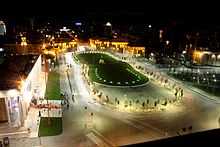
.jpg)
In 2000, former Tirana mayor Edi Rama undertook a campaign to demolish illegal buildings around the city centre and on Lana River banks to bring the area to its pre-1990 state. In addition, Rama led the initiative to paint the façades of Tirana's buildings in bright colours, although much of their interiors continue to degrade.[12][13] Public transport was privatized and newer second hand buses were introduced. Municipal services were expanded, a richer calendar of events introduced and a Municipal Police force established. Most main roads underwent reconstruction, such the Ring Road (Unaza), Kavaja Street and the main boulevard. Common areas between apartment buildings were brought back to normality after decades of neglect, while parks, city squares and sports recreational areas were renovated, giving Tirana a more European look.
Some critics argue that traditional houses are being threatened by continuous construction of apartment buildings, while some green areas are being used for the construction of skyscrapers. In fact, Rama has been accused by critics of political corruption while issuing building permits, but he has dismissed the claims as baseless. Decreasing urban space and increased traffic congestion have become major problems as a general construction chaos is observed in Tirana.
In 2007, U.S. President George W. Bush marked the first time that such a high ranking American official visited Tirana.[14] A central Tirana street was named in his honor. In 2008, the 2008 Gërdec explosions were felt in the capital as windows were shattered and citizens shaken. In 21 January 2011, Albanian police clashed with opposition supporters in front of the Government building as cars were set on fire, three persons killed and 150 wounded.[15]
Outlook
Although much has been achieved, critics argue that there is no clear vision on Tirana's future. Some of the pressing issues facing Tirana are loss of public space due to illegal and chaotic construction, unpaved roads in suburban areas, degradation of Tirana's Artificial Lake, rehabilitation of Skanderbeg Square, an ever present smog, the construction of a central bus station and lack of public parking space. Future plans include the construction of the Multimodal Station of Tirana and the tram line, rehabilitation of the Tiranë River area, construction of a new boulevard along the former Tirana Railway Station and the finishing of the Big Ring Road.
Climate
Tirana has a humid subtropical climate (Cfa in the Köppen climate classification) and receives just enough summer precipitation to avoid Köppen's Csa Mediterranean climate classification, since every summer month has more than 40 millimetres (1.6 in) of rainfall,[16] with hot and moderately dry/humid summers and cool and wet winters. Some snow falls almost every winter, but it usually melts quickly.
| Climate data for Tirana | |||||||||||||
|---|---|---|---|---|---|---|---|---|---|---|---|---|---|
| Month | Jan | Feb | Mar | Apr | May | Jun | Jul | Aug | Sep | Oct | Nov | Dec | Year |
| Record high °C (°F) | 21 (70) |
24 (75) |
27 (81) |
28 (82) |
31 (88) |
36 (97) |
42 (108) |
40 (104) |
40 (104) |
36 (97) |
28 (82) |
22 (72) |
42 (108) |
| Average high °C (°F) | 12 (54) |
13 (55) |
15 (59) |
20 (68) |
24 (75) |
28 (82) |
32 (90) |
32 (90) |
28 (82) |
23 (73) |
17 (63) |
13 (55) |
21.4 (70.5) |
| Daily mean °C (°F) | 7 (45) |
8 (46) |
10 (50) |
14.5 (58.1) |
18.5 (65.3) |
22 (72) |
25 (77) |
25 (77) |
21.5 (70.7) |
17.5 (63.5) |
12.5 (54.5) |
8.5 (47.3) |
15.83 (60.53) |
| Average low °C (°F) | 2 (36) |
3 (37) |
5 (41) |
9 (48) |
13 (55) |
16 (61) |
18 (64) |
18 (64) |
15 (59) |
12 (54) |
8 (46) |
4 (39) |
10.3 (50.3) |
| Record low °C (°F) | −10 (14) |
−9 (16) |
−10 (14) |
−1 (30) |
3 (37) |
8 (46) |
8 (46) |
8 (46) |
3 (37) |
0 (32) |
−6 (21) |
−8 (18) |
−10 (14) |
| Average precipitation mm (inches) | 143 (5.63) |
132 (5.2) |
115 (4.53) |
104 (4.09) |
103 (4.06) |
68 (2.68) |
42 (1.65) |
46 (1.81) |
78 (3.07) |
114 (4.49) |
172 (6.77) |
148 (5.83) |
1,265 (49.81) |
| Avg. precipitation days (≥ 1 mm) | 12 | 10 | 11 | 11 | 10 | 6 | 4 | 4 | 6 | 11 | 13 | 12 | 110 |
| Mean monthly sunshine hours | 127.1 | 124.3 | 158.1 | 204 | 266.6 | 297 | 353.4 | 328.6 | 264 | 217 | 126 | 86.8 | 2,552.9 |
| Source: Wetter.com: Tirana[17] | |||||||||||||
Demographics

According to preliminary data from the 2011 national census, the population of Tirana within city limits is 421,286. Tirana County, which can be viewed as a metropolitan area, has a population of 763,634. Many large towns and villages within the county have merged with the city, due to urban sprawl, so they can be viewed as suburbs of Tirana. Some of the large suburbs, listed as separate towns, are Kamëz (67,301), Kashar (45,742), Paskuqan (37,313) and Farkë (22,713). Thus the urban area of Tirana has a population close to 600,000. When it comes to religion, Muslims represent 55.9% of the population, while large Christian and atheist minorities collectively make up 44.1% of the population.[2]
In 1703, Tirana had about 4,000 inhabitants and by 1820 the number tripled to 12,000. The first census, conducted a few years after becoming capital, showed a total population of 10,845. During the 1950s, Tirana experienced rapid industrial growth and the population increased to about 137,000. After the end of communist rule in 1991, Tirana experienced its fastest population growth when people from rural areas moved to the capital for better economic opportunities. In 1990, Tirana had 250,000 inhabitants, but the large-scale influx increased the population to well over 500,000. Stemming from historical migratory waves, Tirana is known for its hospitality, represented in many traditional songs with the warm hospitality symbols of "bread", "salt" and "heart".
|
| Year | 1703 | 1820 | 1923 | 1937 | 1955 | 1985 | 2001 | 2011 |
|---|---|---|---|---|---|---|---|---|
| Population | 4,000 | 12,000 | 10,845 | 35,000 | 108,200 | 200,000 | 597,899 | 763,634 |
^a Population figures are given inside city limits at that time.
Health
The largest hospital in Tirana is Mother Theresa Hospital (Qëndra Spitalore Universitare Nënë Tereza), which is associated with University of Tirana, Faculty of Medicine. The hospital is a 1,456-bed facility that offers inpatient tertiary care to over 12,000 patients annually. The hospital is undergoing major changes in infrastructure and equipment. A number of private hospitals have been opened.
Culture
Institutions and events
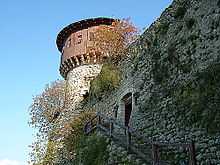

The main cultural institutions of Tirana are the National Theater, the National Theatre of Opera and Ballet of Albania and the National Arts Gallery (Galeria Kombëtare e Arteve). Performances of renowned world composers are regularly performed by the Symphonic Orchestra of the Albanian Radio and Television.
The city serves as a venue for the Tirana Biennale, Tirana Jazz Festival, Summer Day, White Night on 28 November, Rally Albania, Buy Albanian Regional Delicacies Expo, and Tirana Fashion Week. Tirana has been redesigning its identity to a more Mediterranean city, lined with cafes and a "vibrant" nightlife.
Landmarks
Tirana has a rich mosaic of historic land natural landmarks. The town and surrounding area is home to the following natural and historical sites:
- Tirana Castle (Keshtjella e Tiranës), the historical core of the capital around Murat Toptani Street
- Clock Tower of Tirana (Pirgu i Orës) and the nearby Tirana Ethnography and Clock Towers Museum (Muzeu i Oreve)
- Et'hem Bey Mosque (Xhamia e Tiranës)
- Tabak Bridge (Ura e Tabakëve)
- National Historic Museum
- Skanderbeg Square as a monumental ensemble
- Dëshmorët e Kombit Boulevard, a panoramic avenue built by the Italians
- Blloku, the nightlife area of the capital
- Dajti Mountain, overlooking the city and accessible via cable car
- Prezë Castle (Keshtjella e Prezës)
- Petrelë Castle (Keshtjella e Petrelës)
- Castle of Ndroq (Keshtjella e Ndroqit)
- Tirana Mosaic
- Kapllan Pasha's Grave (Varri i Kapllan Pashës)
- Tirana Archaeological Museum
- Natural Sciences Museum of Albania
- Sali Shijaku Traditional House
- Big Park on the Artificial Lake
- St Paul's Cathedral
- Orthodox Church of the Holy Evangelist
- Zemra e Krishtit Catholic Church of Tirana
- Sheh Dyrri Teqe and Global Bektashi Centre
- Dervish Hatixhe Tekke
- Tirana New Bazaar
- Brari Bridge and Canyon
- Pellumbas Cave
- Shengjergji Waterfall
- Erzeni River Canyon
Tirana is home to five well-preserved traditional houses (museum-houses), 56 cultural monuments, eight public libraries and the National Library of Albania (Biblioteka Kombëtare).[21] Since 2011, a Tourist Information Office was opened, located behind the National History Museum, with useful information on Tirana and Albania.
Education
Tirana is host to academic institutions such as the University of Tirana, Polytechnic University of Tirana, Agricultural University of Tirana, Academy of Physical Education and Sports, University of Arts (Academy of Arts of Albania), the Academy of Sciences of Albania, and the Skanderbeg Military University, national and international academic research institutions, as well as NGOs. English Base is an English Language school in Tirana.
Tirana has seen the creation of private academic institutions, including: Albanian University (U.F.O - Universitas.Fabrefacta Optime), Epoka University, University of New York, Tirana, European University of Tirana, Luarasi University, Academy of Film and Multimedia "Marubi".
Municipality

The Municipality of Tirana is divided into 11 administrative units referred to as Njësi Bashkiake (Municipal units). These have their own mayor and council, and sometimes are known as Mini-Bashki (Mini-Municipality).[22]
In 2000, the centre of Tirana from the central campus of Tirana University up to Skanderbeg Square was declared the place of Cultural Assembly, and given state protection. The historical core of the capital lies around pedestrian only Murat Toptani Street, while the most prominent city district is Blloku. Once a secluded and heavily guarded Politbureau residential area, it has turned into a district where the young and fashionable fill the clubs and cafes. Tirana's influential elite live in the village of Selita on Tirana's outskirts. The area is famous for its villa architecture.
Until recently the city lacked a proper address system. In 2010, the municipality undertook the installing of street name signs and entrance numbers while every apartment entrance was physically stamped.[23]
Urban planning

Half a dozen urban plans for Tirana prepared by consultants have included proposals on how to guide development. In 1995, Regional Consulting, a Vienna-based urban planning firm funded by the Austrian government prepared a master plan for Tirana. In 1995, a Land Management Task Force composed of Albanian urban planners, PADCO (a US-based consulting firm), GHK (UK-based consulting firm), and the Graduate School of Design of Harvard University prepared a preliminary structural plan for the Tirana metropolitan area. The plan was updated by PADCO in 2002 into a Strategic Plan for Greater Tirana, which covered the metropolitan area.
In 2002, two German consultants, GTZ GmbH (German Technical Cooperation), and IOER (Institute of Ecological and Regional Development) compiled a development study for the Tirana-Durrës region. Two other site plans for the city center were prepared in 2003 and 2010 by French Architecture Studio, and Belgian architectural firm 51N4E respectively. In 2007, a larger strategic plan for this region followed up made by two UK-based firms, Landell Mills Development Consultants and Buro Happold.
Most of these proposals did not go through the established approval procedures and have unclear legal status. The preparation of a new master plan for Tirana was under way for almost a decade (2002–2011). Two interim reports prepared by Urbaplan - a Swiss consultant, and CoPlan - an Albanian urban planning institute were released in 2007 and 2008 respectively.[24] However, the plan was turned down by the National Planning Council of Albania (KRRTRSH). In the meantime, the Municipality announced in 2011 that a new regulatory plan would be prepared within 2012.[25]
Economy

Tirana is Albania's heart of economy. It is Albania's major industrial and financial centre. Since the 1920s, it has experienced rapid growth and established many industries for agricultural products and machinery, textiles, pharmaceuticals, metal products, and services.
Tirana began to develop at the beginning of the 16th century, when a bazaar was established, and its craftsmen manufactured silk and cotton fabrics, leather, ceramics and iron, silver, and gold artifacts. Sited in a fertile plain, the Tirana area exported 2,600 barrels of olive oil and 14,000 packages of tobacco to Venice by 1769. In 1901, it had 140,000 olive trees, 400 oil mills, and 700 shops. Tirana is known for its native wealthy families. TID tower, an 85 meters business tower is being constructed in the city. Tirana has malls, such as City Park at 3 km2 (1 sq mi), QTU, Casa Italia, and Tirana East Gate.
Environment

The city suffers from problems related to overpopulation, such as waste management, high levels of air pollution and significant noise pollution. Over the last decades, air pollution has become a pressing concern as the number of cars has increased. These are mostly 1990s and early 2000s diesel cars,[26] while it is widely believed that the fuel used in Albania contains larger amounts of sulfur and lead than in the European Union. Another source of pollution are PM10 and PM2.5 inhaled particulate matter and NO2 gases[27][28] resulting from rapid growth in the construction of new buildings and expanding road infrastructure.[29] Untreated solid waste is present in the city and outskirts. Additionally, there have been complaints of excessive noise pollution. Despite the problems, the Big Park at the Tirana Artificial Lake has some effect on absorbing CO2 emissions, while over 2 000 trees have been planted around sidewalks.
Media

Tirana is the media hub of Albania. The city is home to the headquarters of the Albanian Radio and Television (RTSH), and national commercial broadcasters Top Channel and TV Klan. Radio stations operate in the capital, with the most notable being Radio Tirana, commercial Top Albania Radio and Plus 2 Radio.
Tirana is home to the publication of dailies including Shqip, Zëri i Popullit, Shekulli, Gazeta Shqiptare and Koha Jonë.
Sports
Tirana is a major centre for sport in Albania. Tirana's sports clubs include KF Tirana, Partizani, and Dinamo. In football, as of April 2012, the Tirana-based teams have won a combined 57 championships out of 72 championships organized by the FSHF, i.e. 79% of them.
In Tirana there are two major stadiums, the Qemal Stafa Stadium, that holds around 20,000 spectators and the Selman Stërmasi stadium which holds around 12,000 spectators. Tirana's sports infrastructure is developing fast because of the investments from the municipality and the government. From 2007 Tirana Municipality has built up to 80 sport gardens in most of Tirana's neighbourhoods.
Transport

The city serves as the meeting point for national roads SH1, SH2 and SH3. Construction of the outer big ring highway started in 2011. In the near future, Tirana will have a transportation hub combining all transportation in one place near Kashar.
Bus
Local transport within Tirana is by bus or taxi. Official taxis have yellow plates with red text and usually use taximeter. As for the Municipal Countil of Tirana resolution of 2013, flagfall starts at 250 Lek (€1.8) for the first 1.5 km during daytime, and 300 Lek (€2.2) during night and holidays. Tirana taxi fare calculator is available at http://merrtaxi.com/taxi-tirana-cost-trip-calculator
Call a taxi toll free national phone: 0800 55 55 Location sharing and international phone: +355 67 400 6610
Coach and minibus (furgon) services also run to the coast and northern and southern Albania from Tirana. International coach services connect to Greece, via Korçë or Kakavije, to Kosovo[a] via the new Durrës-Morine highway, and to the Republic of Macedonia via Struga.
A web and Android application regarding Tirana's public transportation such as lines, directions, times and costs can be found at Tirana Bus Stations.[30] An Android application is available for download at Google Play Apps.[31]
Rail
There are passenger services to Durrës and Librazhd, via Elbasan. As of September 2013, the Tirana Railway Station north of Skanderbeg Square is being dismantled and moved to Vorë. The existing line was replaced with a bus service located alongside the coach terminal at the north end of Boulevard Zogu I. The line extending from Librazhd to Pogradec was discontinued in 2012. There are no international passenger services, although there is a freight-only railway through Shkodër to Montenegro.
Air

Tirana International Airport Mother Theresa (Nënë Tereza in Albanian), also known as Rinas Airport, was reconstructed in 2007. It is 15 km (9 mi) northwest of the city, off the road to Durrës. It is one of the largest airports in the region.
Sea

Tirana is served by the port of Durrës, 36 km (22 mi) distant from the capital. Passenger ferries from Durrës sail to Trieste, Ancona, Otranto, Brindisi, Bari, Genoa (Italy), Zadar, Dubrovnik (Croatia), Koper (Slovenia), Bar (Montenegro), Corfu (Greece) and others. Kavaja is included in the Tirana County also.
Bicycle
The Ecovolis bicycle sharing system was launched in 2011.[32] Bicycles are rented from initially four stations located at Rinia Park and along Deshmoret e Kombit Boulevard. A full day ride costs 100 leks. Cycling in the streets has been regarded as quite dangerous, because bike lanes are narrow and occupied by cars. However, in recent years, Tirana is investing in cycling infrastructure. Bike only lanes are located alongside existing sidewalks on Skanderbeg Square, Lana River and Kavaja Street, while combined bus and bike lanes are located on other main streets to alleviate overall congestion.
Notable people
Below are some of the most notable personalities born in Tirana or that spent most of their lives in Tirana:
- Abdi bej Toptani, signatory of the Albanian Declaration of Independence
- Agim Sulaj, painter
- Albert Brojka, former Tirana Mayor
- Aleksandër Meksi, former Prime Minister
- Andrea Shundi, Albanian agronomist
- Bamir Topi, former President of Albania
- Beqir Balluku, former member of the Politburo; he was accused of being the organizer of a coup d'état in 1974 and sentenced to death
- Blendi Nallbani, football player
- Breanne Benson, pornstar
- Edi Rama, Prime Minister of Albania
- Elsa Lila, singer
- Erjon Bogdani, football player
- Ermonela Jaho, opera singer
- Essad Pasha, politician
- Fatos Nano, former Prime Minister of Albania
- Gjergj Xhuvani, movie director
- Igli Tare, football player
- Inva Mula, opera singer
- Ismail Ndroqi, mayor of Tiranë
- Kledi Kadiu, dancer and actor who lives and works in Italy
- Kujtim Çashku, Albanian film director and screenwriter
- Leka, Crown Prince of Albania, heir of King Zog I
- Masiela Lusha, actress, poet and writer
- Murat bej Toptani, signatory of the Albanian Declaration of Independence
- Pandeli Majko, twice Prime Minister of Albania
- Rexhep Meidani, former President of Albania
- Saimir Kumbaro, film director
- Sali Kelmendi, former Tirana Mayor
- Skënder Sallaku, comic actor
- Vedat Kokona, translator
- Klodiana Shala, athlete
Honorary citizens
The following persons are honorary citizens:[33]
- George Soros
- Norman Wisdom
- Wolfgang Schüssel
- Ismail Kadare
- Nikita Khrushchev
- Galeazzo Ciano
- Ibrahim Kodra
- Azem Hajdari
- Anton Yugov
- Haxhi Hafiz Sabri Koçi Grand Mufti of Albania.[34]
- Archbishop Anastasios of Albania
- Rrok Mirdita
- Baba Reshat Bardhi
- Robert Shvarc
- Dritëro Agolli
- Hysen Kazazi
- Sadik Kaceli
- Hans Peter Furrer
- Mahatir Bin Mohammed
- Shefqet Ndroqi
- Osman Kazazi
- Sabah Al-Ahmad Al-Jaber Al-Sabah
- Eliza Dushku
- Hamad bin Khalifa Al Thani
- Franco Frattini
- Pope Francis
- Michael Granoff
- Stjepan Mesić
International relations
Twin towns – sister cities
Gallery
|
See also
References and notes
- ↑ "www.tirana.gov.al". www.tirana.gov.al. Retrieved 2013-01-21.
- ↑ 2.0 2.1 "Population and Housing Census in Albania" (PDF). Institute of Statistics of Albania. 2011.
- ↑ (Albanian) Kodi postar Posta Shqiptare. www.postashqiptare.al. Retrieved on 13 November 2008
- ↑ 2011 census results
- ↑ As argued by Prof. Dr. Muzafer Korkuti, an Albanian archeologist and researcher. "Tirane si qëndër e Historisë dhe Trashëgimisë Kulturore"
- ↑ 6.0 6.1 Heppner, Harald (1994). Hauptstädte in Südosteuropa: Geschichte, Funktion, nationale Symbolkraft. Wien u.a. Böhlau. pp. 133, 135. ISBN 978-3-205-98255-5.
- ↑ To know more about the history of Tirana, please consult Tirana ne shekuj: Terona, Theranda, Tirkan, Tirannea, Tirana : monografi, disa artikuj e materiale arkivore kushtuar historisë së Tiranës by Skënder Jasa. (Victoria, 1997)
- ↑ ""Tiranasit" e ardhur rishtaz" (in Albanian). Gazeta Shqiptare. Retrieved 17 August 2008.
- ↑ Pearson, Owen (2006). Albania and King Zog: independence, republic and monarchy 1908–1939. IB Taurus. p. 140. ISBN 1-84511-013-7.
It was decided that the Congress of Lushnje was not to be dissolved until elections had been held and the new government had taken power into its hands and begun to exercise its functions in Tirana, in opposition to the Provisional Government in Italian occupied Durrës
- ↑ Kera, Gentiana. Aspects of the urban development of Tirana: 1820-1939, Seventh International Conference of Urban History. Athens, 2004.
- ↑ Bleta, Indrit. Influences of political regime shifts on the urban scene of a capital city, Case Study: Tirana. Turkey, 2010.
- ↑ "A bright and colourful new style of urban design emerges in Albania". Resource for Urban Design Information. Retrieved 16 August 2008.
- ↑ Pusca, Anca (2008). "The aesthetics of change: Exploring post-Communist spaces". Global Society 22 (3): 369–386. doi:10.1080/13600820802090512.
- ↑ Bush greeted as hero in Albania BBC News
- ↑ "Protesters killed in Tirana rally". SETimes.com. 2011-01-21. Retrieved 2011-09-15.
- ↑ Kottek, Markus; Grieser, Jürgen; Beck, Christoph; Rudolf, Bruno; Rube, Franz (June 2006). "World Map of the Köppen-Geiger climate classification updated" (PDF). Meteorologische Zeitschrift 15 (3): 259–263. doi:10.1127/0941-2948/2006/0130. Retrieved 2011-02-27.
- ↑ Wetter.com: Tirana
- ↑ "Albania: largest cities and towns and statistics of their population". Archived from the original on 5 December 2012. World Gazetteer.2009-12-01
- ↑ (Albanian) Population statistics of the Municipality of Tirana
- ↑ (Albanian) Population projections from INSTAT
- ↑ (Albanian) Statistikat 2007 PDF Municipality of Tirana. Retrieved on 20 July 2008
- ↑ Dorina Pojani (2010-03-06). "Tirana City Profile, Dorina Pojani, (2010), ''Cities'' Volume 27, Issue 6, Pages 483-495". Sciencedirect.com. Retrieved 2013-01-21.
- ↑ "Bashkia - Lajmet e Ditarit". Tirana.gov.al. Retrieved 2011-09-15.
- ↑ Dorina Pojani (March 2011). "Urban and suburban retail development in Albania's capital after socialism". Land Use Policy. doi:10.1016/j.landusepol.2011.02.001.
- ↑ "Top Channel". Citeulike.org. Retrieved 2013-01-21.
- ↑ http://www.youtube.com/watch?v=sK6ZChjF-L8
- ↑ Environmental Center for Administration & Technology Tirana. 2008. Tirana Air Quality Report. Tirana: EU/LIFE Program; German Federal Ministry of the Environment, Nature Protection and Nuclear Safety.
- ↑ "Dako, Alba; Lika, Mirela and Hysen Mankolli. 2008. Monitoring aspects of air quality in urban areas of Tirana and Durrës, Albania. Natura Montenegrina 7, no. 2: 549-557" (PDF). Retrieved 2013-01-21.
- ↑ Cameron, Rob (3 December 2004). "Tirana: Where the streets have no name". BBC News.
- ↑ tiranabuses.com
- ↑ "Tirana Buses - Android-apps op Google Play". Play.google.com. Retrieved 2013-03-12.
- ↑ "Ecovolis". Ecovolis. Retrieved 2013-01-21.
- ↑ "Tirana.gov.al". Tirana.gov.al. Retrieved 2013-01-21.
- ↑ "The Tariqa Tijaniyya » Shaykh Ahmad Tijani and the Islamic Sacred Law (Shari’a)". Tijani.org. Retrieved 2011-09-15.
- ↑ 35.0 35.1 35.2 35.3 35.4 35.5 35.6 35.7 35.8 35.9 35.10 35.11 35.12 35.13 35.14 35.15 35.16 35.17 35.18 35.19 35.20 35.21 35.22 35.23 35.24 35.25 35.26 "Twinning Cities: International Relations" (PDF). Municipality of Tirana. www.tirana.gov.al. Retrieved 23 June 2009.
- ↑ "Kardeş Kentleri Listesi ve 5 Mayıs Avrupa Günü Kutlaması [via WaybackMachine.com]" (in Turkish). Ankara Büyükşehir Belediyesi - Tüm Hakları Saklıdır. Archived from the original on 14 January 2009. Retrieved 2013-07-21.
- ↑ "Barcelona internacional – Ciutats agermanades" (in Spanish). 2006–2009 Ajuntament de Barcelona. Retrieved 13 July 2009.
- ↑ "Sister Cities". Beijing Municipal Government. Retrieved 23 June 2009.
- ↑ "Kardeş Şehirler". Bursa Büyükşehir Belediyesi Basın Koordinasyon Merkez. Tüm Hakları Saklıdır. Retrieved 2013-07-27.
- ↑ Tirana binjakëzohet me Dohan, Tv Klan 2012-02-12 (in Albanian)
- ↑ International Relations. Municipality of Tirana. www.tirana.gov.al. Retrieved on 25 January 2008.
- ↑ Pessotto, Lorenzo. "International Affairs - Twinnings and Agreements". International Affairs Service in cooperation with Servizio Telematico Pubblico. City of Torino. Archived from the original on 2013-06-18. Retrieved 2013-08-06.
Notes:
| a. | ^ Kosovo is the subject of a territorial dispute between the Republic of Serbia and the Republic of Kosovo. The latter declared independence on 17 February 2008, but Serbia continues to claim it as part of its own sovereign territory. Kosovo's independence has been recognised by 108 out of 193 United Nations member states. |
Further reading
- Blocal, Giulia (16 September 2014). "Tirana’s colorful buildings". Blocal Travel blog.
- Williams, Sean (11 July 2014). "Tirana fights to beat its addiction to cars and get its residents cycling". The Guardian. Retrieved 12 July 2014.
- Abitz, Julie. Post-Socialist Development in Tirana. Roskilde: Roskilde Universitetscenter, 2006.
- Agorastakis, Michalis and Giorgos Sidiropoulos. 2007. Population change due to geographic mobility in Albania, 1989–2001, and the repercussions of internal migration for the enlargement of Tirana. Population, Space and Place 13, no. 6, pp. 471–481
- Aliaj, Besnik; Keida Lulo and Genc Myftiu. Tirana: the Challenge of Urban Development, Tirana: Cetis, 2003 ISBN 99927-880-0-3
- Aliaj, Besnik. A Short History of Housing and Urban Development Models during 1945-1990, Tirana 2003.
- Bertaud, Alain. Urban Development in Albania: the Success Story of the Informal Sector, 2006.
- Bleta, Indrit. Influences of Political Regime Shifts on the Urban Scene of a Capital City, Case Study: Tirana. Turkey, 2010.
- Capolino, Patrizia. 2011. Tirana: A Capital City Transformed by the Italians. Planning Perspectives 26, no. 4, pp. 591–615
- Felstehausen, Herman. Urban Growth and Land Use Changes in Tirana, Albania: With Cases Describing Urban Land Claims. University of Wisconsin-Madison, 1999
- Galeteanu, Emira. Tirana: the Spectacle of the Urban Theatre. MA Dissertation. Carleton University: Ottawa, 2006.
- Guaralda, Mirko (2009). Urban Identity and Colour : the Case of Tirana, Albania. Spectrum e-news, 2009(Dec), pp. 13-14.
- Jasa, Skënder. Tirana në shekuj: Terona, Theranda, Tirkan, Tirannea, Tirana: monografi, disa artikuj e materiale arkivore kushtuar historisë së Tiranës, Tirana 1997.
- Kera, Gentiana. Aspects of the Urban Development of Tirana: 1820-1939, Seventh International Conference of Urban History. Athens, 2004.
- Nase, Ilir and Mehmet Ocakci. 2010. Urban Pattern Dichotomy in Tirana: Socio-spatial Impact of Liberalism. European Planning Studies 18, no. 11, pp. 1837–1861
- Pojani, Dorina (2011). Mobility, Equity and Sustainability Today in Tirana, TeMA 4, no. 2, pp.99-109
- Pojani, Dorina. (2010). Tirana. Cities 27, no.6, pp. 483–495
- Pojani, Dorina. 2011. From Carfree to Carfull: the Environmental and Health Impacts of Increasing Private Motorisation in Albania. Journal of Environmental Planning and Management 54, no. 3, pp. 319–335
- Pojani, Dorina. 2011. Urban and Suburban Retail Development in Albania's Capital After Socialism. Land Use Policy 28, no. 4, pp. 836–845
External links
| Wikivoyage has a travel guide for Tirana. |
| Wikimedia Commons has media related to Tirana. |
- Municipality of Tirana (Albanian)
- In Your Pocket City Guide
- Travel guide by Metrolic
- Minibus departure times
- Tirana Nightlife Guide
- Tirana Street Style Fashion
- Tirana Cultural/Natural Guide
- Historical maps
- Travel guide
 |
Kamëz | Paskuqan |  | |
| Kashar | |
Dajt | ||
| ||||
| | ||||
| Vaqarr | Farkë |
| |||||||||||||||||||||
| ||||||
| ||||||
| ||||||||||||||||||||||||||||||
| |||||||||||||||||||||||||||||||||||||||||




